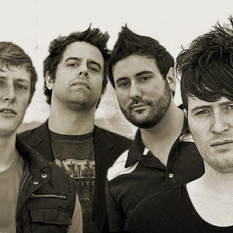Emo pop began in the 1990s reinvention of emo replacing the punk sound of emo with a pop punk sound. Bands like The Get Up Kids, Jimmy Eat World, The Promise Ring, Saves the Day and Midtown are early emo pop bands. As emo became an increasingly marketable style during the early 2000s, many artists shifted away from the artsy, unconventional song structures that characterized the genre’s early days. While retaining emo’s confessional lyrics and cathartic energy, groups like Jimmy Eat World also embraced more pop-oriented influences, often simplifying their approach with concise songs and hook-laden choruses. This spin-off genre attracted a significantly younger audience, as its sound blended youthful angst with slick production and mainstream appeal. Jimmy Eat World officially launched the emo-pop movement in 2001 with Bleed American, whose flagship single “The Middle” became a top 5 hit. Emo-pop soon established itself as a genre that relied on high-pitched melodies, rhythmic guitars, and lyrics concerning adolescence, relationships, and heartbreak.
As the genre took hold, labels like Fueled By Ramen emerged as epicenters of the emo-pop movement, issuing platinum-selling albums by Fall Out Boy, Panic at the Disco, and Paramore. Emo-pop was a decidedly American phenomenon with particular strongholds in Florida (the home state of both Fueled by Ramen and Dashboard Confessional) and the Midwest. A native of Illinois, Fall Out Boy’s Pete Wentz was instrumental in strengthening the genre’s ties to the region, even launching his own vanity label, Decaydance, to help foster younger groups. While bands like My Chemical Romance retained a dark, neo-gothic edge, emo-pop was largely a bright, spirited genre that wielded more commercial influence than emo and screamo. .

